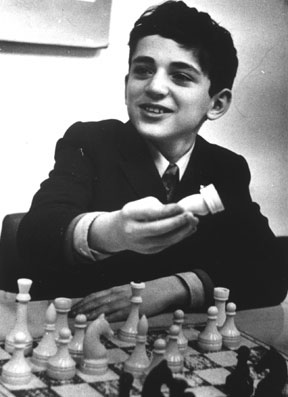


 25th March 1974, Moscow. The All-Union Tournament of Pioneers Palaces has reached the final phase. There are just six teams competing in this last round and they have come up the hard way knocking out everyone else. The kids are excited as now grandmasters heading rival teams are going to give simultaneous displays against them.
25th March 1974, Moscow. The All-Union Tournament of Pioneers Palaces has reached the final phase. There are just six teams competing in this last round and they have come up the hard way knocking out everyone else. The kids are excited as now grandmasters heading rival teams are going to give simultaneous displays against them.
Among the kids is a little boy from Baku, Azerbaijan.
He is barely 11years-old and today he experiences a real shock. Before him stands a living legend- Misha Tal! Is this a dream? No, the maestro even shakes hands with him and a mild tremor passes through the little kid.
Is he scared now that he is going to cross swords with his hero? No! Sure, he has heard about the hypnotic glare with which Misha would intimidate his opponents. But our little fellow is not afraid. At last the battle begins and blow follows blow with even the maestro giving a broad smile appreciative of the young talent’s play. It’s only in the end that our hero succumbs. He is a kid after all.
Years pass and the boy from Baku grows up to become powerful grandmaster. He wins the USSR Championship and also the Moscow Interzonal to become a world championship candidate. His name is Garry Kasparov.
Meanwhile the maestro’s star has waned. Dazzling success alternates with disastrous defeat. The former world champion even fails to qualify from the Interzonal that he had won before. To all appearances he is no longer a force to reckon with.

But then Tal remains Tal! Sparks fly when Misha meets Garry Kasparov at the next event. Kasparov’s original annotations to this encounter are extraordinarily deep and complex. I have simplified them a bit and added a little more analysis in the light of current theory.


[Event "Spartakiad "] [Site "?"] [Date "1983.??.??"] [Round "?"] [White "Garry Kasparov"] [Black "Mikhail Tal"] [Result "1/2-1/2"] [ECO "D44"] [PlyCount "86"] [EventDate "1983.??.??"] 1. d4 Nf6 2. c4 e6 ({In his early years Tal played the King's indian Defence with} 2... g6 3. Nc3 Bg7 {and had great success. Decades later Kasparov followed his example.}) ({Similarly in those days Tal played the Moden Benoni with} 2... c5 3. d5 e6 4. Nc3 exd5 5. cxd5 d6 {followed by...g6, Bg7 and...0-0. Subsequently it became part of Garry's arsenal as well.}) 3. Nf3 {A flexible move that allows the "softer" Queen's Indian Defence with 3...b6 and 4...Bb7.} ({On the other hand he does not permit the strategically complex Nimzo-Indian, } 3. Nc3 Bb4 {offering greater possibilities for Black.}) 3... d5 ({After} 3... b6 {Garry had scored quite a few victories with the Petrosian Variation,} 4. a3 Bb7) 4. Nc3 c6 {Finally, the players have reached Semi-Slav Defence by transposition.} 5. Bg5 {Here comes the Anti-Meran Variation.} (5. e3 Nbd7 { leads to the tranquil waters of Meran Defence.}) 5... dxc4 {The Botvinnik System with which the 6th World Champion scored a number of sterling victories. It's an exquisite irony that the foremost exponent for White against this system is the Patriarch's own disciple, Garry Kasparov.} ({In their previous encounter at Moscow Interzonal 1982 Tal opted for} 5... h6 {(Moscow Variation) and Garry responded with the Anti-Moscow Gambit, sacrificing the c-pawn.} 6. Bh4 (6. Bxf6 Qxf6 {is the main line.}) 6... dxc4 {and the game was drawn in an unclear position after Garry had sacrificed a piece.}) 6. e4 b5 7. e5 h6 8. Bh4 g5 9. Nxg5 (9. exf6 gxh4 10. Ne5 Qxf6 {does not promise much for White.}) (9. Bg3 Nd5 {is less played, although players like Nakamura and more recently Rogozenco have had some success with the line.}) 9... hxg5 10. Bxg5 Nbd7 11. exf6 Bb7 ({If} 11... Nxf6 $2 12. Qf3 ({But not the other way round.} 12. Nxb5 $2 cxb5 13. Qf3 Bb4+ $19) 12... Be7 13. Nxb5 $16) 12. g3 c5 (12... Nxf6 {is seldom played and hardly mentioned in theory books. After} 13. Bg2 ({Not} 13. Qf3 $2 Be7 14. Bxf6 (14. Nxb5 $4 Qa5+ $1 $19) 14... Bxf6 15. Nxb5 Rb8 16. Nd6+ Qxd6 17. Qxf6 Qb4+ 18. Kd1 Rg8 $17) 13... Be7 14. O-O {White threatens 15.Bxb5. A possible line is} a6 15. a4 Qd7 16. Qf3 Nd5 17. Bxe7 Qxe7 18. Ne4 $16) 13. d5 Qb6 ({Now} 13... Nxf6 {can be played. After} 14. Bg2 Be7 15. O-O (15. Nxb5 Qa5+ 16. Nc3 Nxd5 $17) 15... Nxd5 16. Bxe7 Kxe7 17. Nxb5 Qb6 18. Na3 $1 ({If} 18. Nc3 $2 Nxc3 19. bxc3 Bxg2 20. Kxg2 Qb7+ 21. Kg1 Rxh2 $1 $19) 18... c3 $13 {the position is unclear.} ({Not} 18... Qxb2 $2 19. Rb1 Qxa3 20. Rxb7+ Kf6 21. Bxd5 exd5 22. Qxd5 $18)) 14. Bg2 O-O-O 15. O-O b4 16. Na4 Qb5 {In recent years this move has run into trouble.} ({Alexie Shirov commends} 16... Qa6 $1 {The queen targets the knight on a4, guards the vulnerable pawn on e6 and remains ready to occupy the diagonal b7-h1 in case the bishops are exchanged.} 17. a3 Bxd5 $1 18. Bxd5 Ne5 19. axb4 Rxd5 20. Qe2 cxb4 $13) 17. a3 Nb8 $6 {A paradoxical retreat. Black intensifies the pressure on d-file and hopes to return with the knight to c6. However, all this costs some precious tempi.} ({After the standard} 17... exd5 18. axb4 cxb4 19. Bf4 {has come into vogue. If} Nxf6 $2 20. Qd4 Qa6 21. h4 {followed by 22.Bh3+ gives White the attack.}) (17... Bxd5 $2 {fails to} 18. Bxd5 Ne5 19. Bxe6+ {If the queen had retreated to a6, this idea would not have worked.}) 18. axb4 cxb4 19. Be3 $6 {Garry is self-critical. Here he questions his own move and instead recommends 19. Qd4 or 19. Qg4.} ({ As tournament practice has shown,} 19. Qg4 $1 {is stronger. The queen moves away from the d-file and targets e6.} Bxd5 20. Rfc1 Nc6 21. Bxd5 Rxd5 22. Rxc4 Rxg5 23. Qe4) 19... Bxd5 20. Bxd5 Rxd5 21. Qe2 Nc6 22. Rfc1 Ne5 $1 {A daring move. He offers the a-pawn, clearing the path for the White rook when his own king remains exposed to attack. He is taking these appalling risks because he is preparing an attack of his own against the White king.} ({Two years before this encounter Kasparov had scored spectacular victories against} 22... Na5 $2 {played by Timoschenko and Dorfman.}) 23. b3 ({Not} 23. Bxa7 $2 Kb7 $1 24. Be3 Rd3 $1 $17 {Threatening 25...Qc6 and ...Nf3+ sets problems for White. For example,} 25. f4 $2 Rxh2 26. Kxh2 Rxe3 27. Qd1 Rd3 28. Qh1+ Nf3+ 29. Kg2 Qc6 30. Rd1 Re3 $19 {If} 31. Kh3 e5 $1) 23... c3 24. Nxc3 $1 {The knight was doing nothing on a4. At least this sacrifice opens lines against Black king.} bxc3 25. Rxc3+ Kb8 26. Qc2 {Garry spent 42 minutes before settling for this move and much of it was to decide whether to take the a7 pawn or not.} (26. Bxa7+ Kb7 27. Qc2 (27. Qe4 Qb4 28. Qc2 Bd6 29. h4 ({Not} 29. Ra4 $2 Nf3+ $3 30. Rxf3 (30. Kg2 Ne1+ 31. Kf1 Nxc2 32. Rxb4+ Nxb4 $19) 30... Qe1+ 31. Kg2 Rxh2+ 32. Kxh2 Rh5+ 33. Kg2 Qh1#) 29... Ra5 30. Rxa5 Qxa5 {and Black should win as the knight outweighs the White pawns.}) 27... Bd6 28. b4 {transposes to the game.}) 26... Bd6 $1 {Combining attack and defence.} (26... Nf3+ $6 {is weak.} 27. Kg2 Ne1+ (27... Rxh2+ $2 28. Kxf3 Rf5+ 29. Kg4 $1 Rf4+ $6 30. Bxf4+ $1 (30. gxf4 $4 Qh5+ 31. Kg3 Qh3#) (30. Kxf4 $4 Bd6+ 31. Kf3 Qh5+ $19)) 28. Rxe1 Bb4 29. Rc1 Bxc3 30. Qxc3 $44) 27. Bxa7+ Kb7 28. b4 $1 Nc6 $6 {Threatening both 29...Nxa7 and 29...Be5 winning material. Yet it is not the strongest move according to Garry.} (28... Bxb4 $2 29. Rc7+ Ka8 30. Bb6+ Kb8 31. Rb7+ $1 Kxb7 32. Qc7#) ( 28... Qxb4 $2 29. Rb3 $18) ({The best move is} 28... Ra8 $1 29. Ra5 $8 Qd7 { Threatening 30...Nc6!} 30. Bb6 $1 Ra6 {Forcing exchange of rooks on his terms.} ({Not} 30... Raxa5 31. bxa5 (31. Bxa5 Nc6 $17) 31... Ka6 $15) 31. Rxa6 Kxa6 32. Bc5 Kb7 {and Black should win with careful play.}) 29. Be3 {Garry saves his bishop and gives up his rook.} Be5 {Tal spent 32 minutes before deciding on this move.} ({He was first inclined to play} 29... Rc8 $5 {and even wrote the move on his scoresheet. After the game in joint analysis both players concluded that} 30. Qh7 {is the best move here. After} ({Tal did not like the reply} 30. f4 $5 {But this is easily met by} e5 ({He calculated} 30... Bxb4 31. Rb1 {missing} Na7 $1 ({He only saw} 31... Bxc3 $2 32. Rxb5+ Rxb5 33. Qxc3 $18) 32. Rxc8 Nxc8 33. Rc1 Qd7 34. Rb1 Qb5)) 30... Be5 31. Qxf7+ ({Not} 31. Rxc6 Qxc6 $1 32. Qxf7+ Rc7 33. Ra7+ Kb8 {White cannot save himself against the threats of 34...Rxf7 and 34...Rd1+ at the same time.}) 31... Rc7 32. Qe8 Rd8 33. f7 Bxc3 34. Qxd8 Nxd8 ({Or} 34... Bxa1 35. Qg8 Rd7 36. f8=Q Rd1+ 37. Kg2 Qf1+ 38. Kf3 Ne5+ 39. Kf4 Qc4+ 40. Kg5 Qg4+ 41. Kh6 Qh3+ 42. Kg5 Qg4+ $11) 35. Ra7+ Kc8 36. Ra8+ Kb7 37. Ra7+ $11) 30. Rxc6 Bxa1 31. Rc7+ Kb8 32. Ba7+ ({Not} 32. Rxf7 $2 Rd7 33. Re7 Bxf6 34. Rxe6 Bd4 $19) 32... Ka8 33. Be3 {Threatening mate with 34.Qa2+} Kb8 34. Ba7+ Ka8 {A useful repetition before time control. But now what?} 35. Bc5 Kb8 36. Rxf7 $1 Be5 37. Ba7+ ({Garry writes, at the board he was not able to assess the variation} 37. Re7 $1 Rhd8 (37... Bxf6 38. Bd6+ $18) 38. f7 Rd1+ 39. Kg2 Qc6+ $1 40. Kh3 Qf3 $1 41. Qh7 $8 {Stopping 41... Rh8+ and also threatening 42.Re8 and f7-f8=Q.} Bxg3 $1 42. fxg3 R1d5 {Forcing White to find a draw with "only" moves.} ({Or Black can play the easier move} 42... Qf1+ $11 {and draw by perpetual check.}) 43. Rb7+ $1 Kc8 (43... Kxb7 $4 44. f8=Q+ $18) 44. Rc7+ $1 Kb8 45. Rb7+ $11) 37... Ka8 38. Be3 Rd7 $1 39. Qa2+ $2 {An error in time trouble.} (39. Rxd7 $1 Qxd7 40. f7 $1 {would have maintained dynamic balance according to Garry. Note that} Qxf7 $4 {fails to} 41. Qe4+ Qb7 42. Qxe5 $18) 39... Kb8 40. Ba7+ $1 (40. Qxe6 $2 {fails to} Rd1+ 41. Kg2 Qf1+ ({Garry endorses Igor Stohl's recommendation} 41... Rd6 42. Qb3 Rd3 43. Qe6 Rxe3 $1 {But after} 44. Rh7 (44. fxe3 $4 Qe2+ $19) 44... Re8 (44... Rxh7 45. Qg8+ Kb7 46. Qxh7+ Kb6 47. fxe3 Qe2+ 48. Kh3 Qf1+ 49. Kg4 Qxf6 $11 { and White cannot escape from checks.}) 45. Re7 Rf8 46. f7 Rd3 47. Re8+ Rd8 48. Qxe5+ Qxe5 49. Rxe5 Rxf7 {matters are not so clear. Black rooks have to cope with four White passed pawns!}) 42. Kf3 Qh1+ 43. Kg4 Qe4+ 44. Kg5 Rg8+ 45. Rg7 Bxf6+ $1 46. Kxf6 ({Or} 46. Qxf6 Rd5+ 47. Kh6 Rh8+ $19) 46... Qxe6+ 47. Kxe6 Rxg7 $19 {Analysis by ChessBase.}) 40... Kc8 {A resourceful monarch! All along he has saved himself with "only" moves.} 41. Qxe6 Qd5 ({Not} 41... Kd8 $2 42. Rxd7+ Qxd7 43. Qxe5 {Threatening both 44.Qb8+ and also 44.f7. Either way the rook is lost.} Qxa7 44. f7 Qxf7 ({Or} 44... Rf8 45. Qd6+ $18) 45. Qxh8+ Kd7 46. h4 $18) 42. Qa6+ Qb7 $6 {Fatigue!} ({He could have played for a win with} 42... Kd8 $1 {But after} 43. Bb6+ Ke8 44. Rxd7 Kxd7 45. Qa7+ Ke6 46. Qe7+ Kf5 47. f7 Bg7 48. h4 Kg6 49. b5 Qxf7 {it is not easy for Black to escape from checks, if at all.}) 43. Qc4+ Qc7 $1 {Threatening to exchange queens or rooks and so forcing back the White queen to a6. Draw on account of perpetual check.Times:2. 35-1.30.} (43... Kd8 {also draws.But Black has to be careful.} 44. Rxd7+ Qxd7 ( 44... Kxd7 $4 45. Bc5 $18) 45. Bb6+ Bc7 (45... Ke8 $2 46. Qe2 $1 $18) 46. Bc5 Bd6 $11) 1/2-1/2
An epic battle! But it’s only a draw. Here is how he used to win his games, enthralling the spectators.

[Event "Simultaneous Display "] [Site "?"] [Date "1959.??.??"] [Round "?"] [White "Tal"] [Black "Kirjatsky"] [Result "1-0"] [ECO "C89"] [PlyCount "81"] [EventDate "1959.??.??"] 1. e4 e5 2. Nf3 Nc6 3. Bb5 a6 4. Ba4 Nf6 5. O-O Be7 6. Re1 b5 7. Bb3 O-O 8. c3 d5 {The Marshall Attack} 9. exd5 e4 {The Steiner Variation, dangerous but unsound.} (9... Nxd5 10. Nxe5 Nxe5 11. Rxe5 c6 {is the Main Line.}) 10. dxc6 exf3 11. d4 $1 (11. Qxf3 Bg4 12. Qg3 Bd6 $13 {gives Black counterplay.}) ({The safer} 11. g3 Re8 12. d4 Bg4 13. Bg5 {was seen in Nakamura-Short, London Chess Classic 2010 and White won. (1-0, 34 moves)}) 11... Bd6 12. Bg5 Bxh2+ 13. Kxh2 Ng4+ 14. Kg1 Qxg5 15. Qxf3 Bf5 ({Not} 15... Qh4 $4 16. Qxf7+ $1 $18) ({A few years ago Black tried} 15... h5 16. Qg3 ({White also has to be careful.If} 16. Bxf7+ $2 Rxf7 17. Re8+ Kh7 18. Qxf7 $4 Qc1+ $19) 16... h4 17. Qf3 Bf5 18. Nd2 Rae8 19. Ne4 Bxe4 20. Rxe4 Rxe4 21. Qxe4 h3 22. g3 Nf6 23. Qe5 Qxe5 24. dxe5 $16 {Klichev-Khasanov, Zaraisk 2009}) 16. Nd2 h5 $2 {Tempting, but weak as it hands over the control of e-file to Black.} (16... Rae8 $5 {is the more resilient try, although it also fails in the end.} 17. Nf1 (17. Ne4 Bxe4 18. Rxe4 Rxe4 19. Qxe4 {allows} Qh4 {giving Black counterchances.}) 17... h5 18. Qg3 h4 19. Qxc7 Be4 $1 {Threatening...Nxf2 followed by...Qxg2+} 20. f3 Rc8 21. Bxf7+ Kh8 22. Qxc8 $1 Rxc8 23. Rxe4 Nf6 24. Re5 Qf4 25. Rc5 Rc7 26. Bg6 Qd6 27. Re1 Rxc6 28. Rh5+ $1 Kg8 29. Rxh4 Qd5 {and now White would have finished in short order with} 30. Re5 Qxa2 31. Re7 Kf8 32. Ra7 $18 {He won any way in Kofman-Kopaev, Kiev, 1948 (1-0, 50 moves).}) 17. Ne4 Bxe4 18. Rxe4 $16 Kh7 19. Bc2 Kh8 20. Rae1 f5 21. Re7 f4 {Preparing...Qh4 next move} ({The immediate} 21... Qh4 {would be premature on account of} 22. Qg3) 22. d5 Qh4 23. d6 (23. Qh3 $2 {is simply met by} Qxf2+ $19) 23... Qh2+ 24. Kf1 Qh4 25. Ke2 Rad8 26. Rh1 $3 {Tal is Tal!} ({Not} 26. dxc7 $4 Qxe7+ $19) 26... Qxh1 27. Qe4 Nf6 28. Qg6 Rg8 29. dxc7 Rdf8 30. c8=Q Rxc8 31. Qxf6 $1 f3+ ({If} 31... gxf6 $4 32. Rh7#) 32. gxf3 Rce8 33. Be4 Rxe7 34. Qxe7 Qc1 35. Qe5 Qxb2+ 36. Kf1 Qc1+ 37. Kg2 Qh6 38. c7 Rf8 39. Qf5 $1 g6 ({Not} 39... Rxf5 $4 40. c8=Q+ Kh7 41. Bxf5+ $18) 40. Qxf8+ $3 ({After the prosaic} 40. c8=Q Rxc8 41. Qxc8+ $18 {Black is lost.But Tal has not finished yet.}) 40... Qxf8 41. Bb7 {Elegant till the end.} 1-0
The Maestro is gone, the magic lingers...
The first version of this article appeared in:
|
| Advertising |